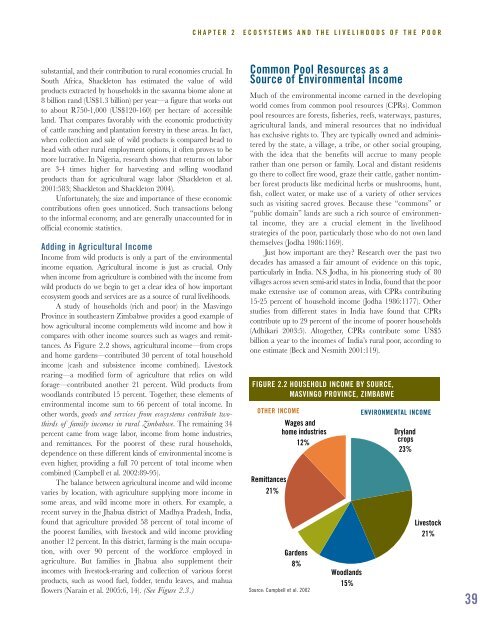jp8589 WRI.qxd - World Resources Institute
jp8589 WRI.qxd - World Resources Institute
jp8589 WRI.qxd - World Resources Institute
You also want an ePaper? Increase the reach of your titles
YUMPU automatically turns print PDFs into web optimized ePapers that Google loves.
CHAPTER 2<br />
ECOSYSTEMS AND THE LIVELIHOODS OF THE POOR<br />
substantial, and their contribution to rural economies crucial. In<br />
South Africa, Shackleton has estimated the value of wild<br />
products extracted by households in the savanna biome alone at<br />
8 billion rand (US$1.3 billion) per year—a figure that works out<br />
to about R750-1,000 (US$120-160) per hectare of accessible<br />
land. That compares favorably with the economic productivity<br />
of cattle ranching and plantation forestry in these areas. In fact,<br />
when collection and sale of wild products is compared head to<br />
head with other rural employment options, it often proves to be<br />
more lucrative. In Nigeria, research shows that returns on labor<br />
are 3-4 times higher for harvesting and selling woodland<br />
products than for agricultural wage labor (Shackleton et al.<br />
2001:583; Shackleton and Shackleton 2004).<br />
Unfortunately, the size and importance of these economic<br />
contributions often goes unnoticed. Such transactions belong<br />
to the informal economy, and are generally unaccounted for in<br />
official economic statistics.<br />
Adding in Agricultural Income<br />
Income from wild products is only a part of the environmental<br />
income equation. Agricultural income is just as crucial. Only<br />
when income from agriculture is combined with the income from<br />
wild products do we begin to get a clear idea of how important<br />
ecosystem goods and services are as a source of rural livelihoods.<br />
A study of households (rich and poor) in the Masvingo<br />
Province in southeastern Zimbabwe provides a good example of<br />
how agricultural income complements wild income and how it<br />
compares with other income sources such as wages and remittances.<br />
As Figure 2.2 shows, agricultural income—from crops<br />
and home gardens—contributed 30 percent of total household<br />
income (cash and subsistence income combined). Livestock<br />
rearing—a modified form of agriculture that relies on wild<br />
forage—contributed another 21 percent. Wild products from<br />
woodlands contributed 15 percent. Together, these elements of<br />
environmental income sum to 66 percent of total income. In<br />
other words, goods and services from ecosystems contribute twothirds<br />
of family incomes in rural Zimbabwe. The remaining 34<br />
percent came from wage labor, income from home industries,<br />
and remittances. For the poorest of these rural households,<br />
dependence on these different kinds of environmental income is<br />
even higher, providing a full 70 percent of total income when<br />
combined (Campbell et al. 2002:89-95).<br />
The balance between agricultural income and wild income<br />
varies by location, with agriculture supplying more income in<br />
some areas, and wild income more in others. For example, a<br />
recent survey in the Jhabua district of Madhya Pradesh, India,<br />
found that agriculture provided 58 percent of total income of<br />
the poorest families, with livestock and wild income providing<br />
another 12 percent. In this district, farming is the main occupation,<br />
with over 90 percent of the workforce employed in<br />
agriculture. But families in Jhabua also supplement their<br />
incomes with livestock-rearing and collection of various forest<br />
products, such as wood fuel, fodder, tendu leaves, and mahua<br />
flowers (Narain et al. 2005:6, 14). (See Figure 2.3.)<br />
Common Pool <strong>Resources</strong> as a<br />
Source of Environmental Income<br />
Much of the environmental income earned in the developing<br />
world comes from common pool resources (CPRs). Common<br />
pool resources are forests, fisheries, reefs, waterways, pastures,<br />
agricultural lands, and mineral resources that no individual<br />
has exclusive rights to. They are typically owned and administered<br />
by the state, a village, a tribe, or other social grouping,<br />
with the idea that the benefits will accrue to many people<br />
rather than one person or family. Local and distant residents<br />
go there to collect fire wood, graze their cattle, gather nontimber<br />
forest products like medicinal herbs or mushrooms, hunt,<br />
fish, collect water, or make use of a variety of other services<br />
such as visiting sacred groves. Because these “commons” or<br />
“public domain” lands are such a rich source of environmental<br />
income, they are a crucial element in the livelihood<br />
strategies of the poor, particularly those who do not own land<br />
themselves (Jodha 1986:1169).<br />
Just how important are they? Research over the past two<br />
decades has amassed a fair amount of evidence on this topic,<br />
particularly in India. N.S Jodha, in his pioneering study of 80<br />
villages across seven semi-arid states in India, found that the poor<br />
make extensive use of common areas, with CPRs contributing<br />
15-25 percent of household income (Jodha 1986:1177). Other<br />
studies from different states in India have found that CPRs<br />
contribute up to 29 percent of the income of poorer households<br />
(Adhikari 2003:5). Altogether, CPRs contribute some US$5<br />
billion a year to the incomes of India’s rural poor, according to<br />
one estimate (Beck and Nesmith 2001:119).<br />
FIGURE 2.2 HOUSEHOLD INCOME BY SOURCE,<br />
MASVINGO PROVINCE, ZIMBABWE<br />
OTHER Other INCOME Income<br />
Remittances<br />
21%<br />
Wages and<br />
home industries<br />
12%<br />
Gardens<br />
8%<br />
Source: Campbell et al. 2002<br />
Woodlands<br />
15%<br />
ENVIRONMENTAL Environmental INCOME Income<br />
Dryland<br />
crops<br />
23%<br />
Livestock<br />
21%<br />
39

















